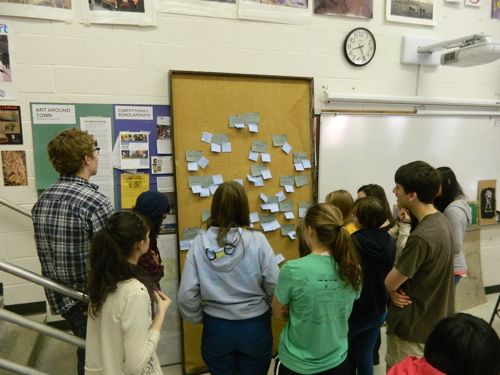
Students in Jack Watson’s Studio Art class at Chapel Hill High School contemplate the post-it wall, where they have brainstormed information about areas of conflict for a unit on Borders and Boundaries. They will later find collaborators using this same wall.
Teachers understand the importance of modeling for students how to act as artists. This sometimes means that we shift roles and practice our craft in the classroom. We might work on a piece of our own as a technique demonstration or steal away to a corner of the room for a few minutes to work on a painting or impromptu collage, knowing that curious eyes will follow. We share finished work with students, and even invite them to our shows. But how often do we show them how we work with other adults as teachers or artists? Teachers of contemporary art—those who emphasize process, concept, collaboration, and reflection—might find this a more instructive demonstration of the artist’s process than a technical demonstration.
This year, I have had the good fortune to collaborate with some talented, inspiring, and far flung colleagues on different projects (including, in the interest of full disclosure, the maestro himself, Joe Fusaro, who invited me to guest blog). This involved planning curriculum around a common theme (beauty and the mundane); incorporating non-traditional media and experimental processes; viewing and discussing relevant artists together (Janine Antoni and Ann Hamilton); and developing a series of works around a big idea. The students met each other through Skype, shared images on Pinterest, sent videos and images via email, and traded handwritten process constraints through old fashioned snail mail. While we wrung our hands a bit at the results, we all marveled at how rejuvenating the collaboration was to our practice, and how that new energy was palpable to students.
We approached our collaboration as an experiment and as such we did not have a rigid structure or elaborate unit plan. We were transparent about our decisions and at times invited our students to participate in the process (my students, for example, determined their own criteria for assessment). This experimental approach was liberating and energizing for most involved, although a few students still craved the comfort and familiarity of a traditional curriculum. Following our model, the students formed their own collaborations naturally and began to view their classmates as resources, working through ideas or stumbling blocks together, rather than instinctually turning to me for solutions. This took some reigning in at times because it could veer into total distraction if unchecked—but a little freedom to get distracted and lose direction is okay. Part of the reason why collaboration works is that it is more fun than working by yourself!
To speak broadly, contemporary artists are inherently collaborators who explore questions and ideas through interactions with others. Meaning is generated not just by the artist but by the people who participate in the work, be it in planning, production, or presentation. Why, then, do we still reinforce the notion of art as an isolated and individualized practice, or “self-expression”? As art educators like Olivia Gude have so astutely pointed out, the modernist concept of artist-as-solitary-genius is fraught with problematic notions of elitism and alienation, and might do more harm than good to the learners we hope to inspire. So what would happen if we stopped modeling how to work and started modeling how to work with others?




Pingback: Revamping Art Education for the Twenty-First Century | ART21 Magazine